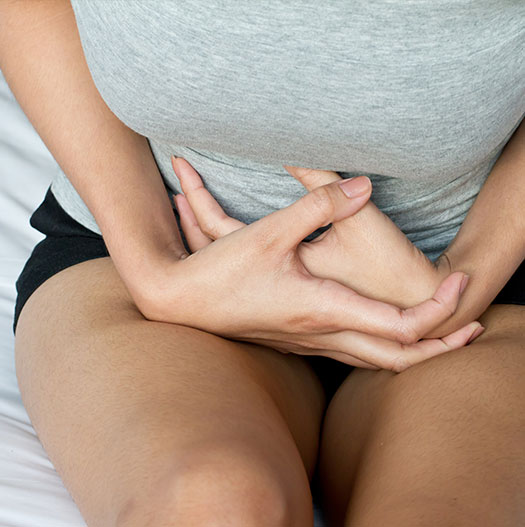Fibroids
Fibroids are spherical nodes composed of uterine muscle cells. They can be of different sizes, varying in number and also variously positioned in relation to the uterine cavity. More than 70% of women of childbearing age have some, albeit small, fibroids. But only 20 percent of these women develop problems related to fibroids throughout their lives.
What sort of problems can fibroids cause?
- If the fibroids are located close to the mucous membrane of the uterine cavity, this is can result in stronger, longer and irregular menstrual bleeding.
- Sometimes due to the presence of fibroids, bodily changes can occur such as pains of the lower abdomen, often in relation to the menstrual cycle.
- If the fibroids are larger in size, they can interfere with other organs – such as the bladder, intestines.
- In certain cases depending on the location of the fibroid, the ability of a woman to become pregnant and maintain the pregnancy can be affected.
- In extreme cases, the volume of the abdomen may increase
But it is also true that multiple large fibroids may not cause any sort of difficulties whatsoever. After the menopause, due to a decrease in hormone levels, fibroids tend to shrink. There is a slight risk (less than 1%) that fibroids can develop into cancer (sarcoma). The fibroid, which is noticeably rapidly growing, needs to be removed and the tissue examined. Fortunately, fibroids are usually well accessible by ultrasound examination through the vulva. In case of uncertainty, magnetic resonance (MRI) or computed tomography (CT) can assist us.

- If the fibroids are located close to the mucous membrane of the uterine cavity, this is can result in stronger, longer and irregular menstrual bleeding.
- Sometimes due to the presence of fibroids, bodily changes can occur such as pains of the lower abdomen, often in relation to the menstrual cycle.
- If the fibroids are larger in size, they can interfere with other organs – such as the bladder, intestines.
- In certain cases depending on the location of the fibroid, the ability of a woman to become pregnant and maintain the pregnancy can be affected.
- In extreme cases, the volume of the abdomen may increase
But it is also true that multiple large fibroids may not cause any sort of difficulties whatsoever. After the menopause, due to a decrease in hormone levels, fibroids tend to shrink. There is a slight risk (less than 1%) that fibroids can develop into cancer (sarcoma). The fibroid, which is noticeably rapidly growing, needs to be removed and the tissue examined. Fortunately, fibroids are usually well accessible by ultrasound examination through the vulva. In case of uncertainty, magnetic resonance (MRI) or computed tomography (CT) can assist us.
What are the options for treating fibroids?

As a general rule, we treat fibroids if they cause discomfort to the woman. Asymptomatic fibroids, such as those that do not cause problems, we only monitor preventively.
Pharmacological. Fibroids have receptors to the hormone progesterone. When using blockers (GnRH-Analogs), the growth and reduction of nodes are usually stopped. At present, Ulipristalacetate, which belongs to the group of selective progesterone receptor modulators (SPRM), is used for treatment. Treatment should be administered at a good tolerability of 3-6 months. There is also a rapid arrest of menstrual bleeding, so women can recover from anemia and replenish iron reserves.
Embolization(under CT control of targeted blockage of the uterine artery) due to the death of myoma tissue and its substitution by a scar tissue formation.

As a general rule, we treat fibroids if they cause discomfort to the woman. Asymptomatic fibroids, such as those that do not cause problems, we only monitor preventively.
Pharmacological. Fibroids have receptors to the hormone progesterone. When using blockers (GnRH-Analogs), the growth and reduction of nodes are usually stopped. At present, Ulipristalacetate, which belongs to the group of selective progesterone receptor modulators (SPRM), is used for treatment. Treatment should be administered at a good tolerability of 3-6 months. There is also a rapid arrest of menstrual bleeding, so women can recover from anemia and replenish iron reserves.
Embolization(under CT control of targeted blockage of the uterine artery) due to the death of myoma tissue and its substitution by a scar tissue formation.
Operative – According to the size and position of the fibroid, we use endoscopy (through the cavity of the uterus – hysteroscopy, or through the abdominal cavity – laparoscopy). At a large finding, we sometimes need to use the classic method with opening the abdominal cavity. If a woman is of childbearing age and does not exclude pregnancy in the future, we aim to remove only myomatous nodules and suture the surrounding tissue in such a way that it can serve in the future for gravidity. If a woman is no longer of childbearing age, it is possible to consider removing the entire uterus.






